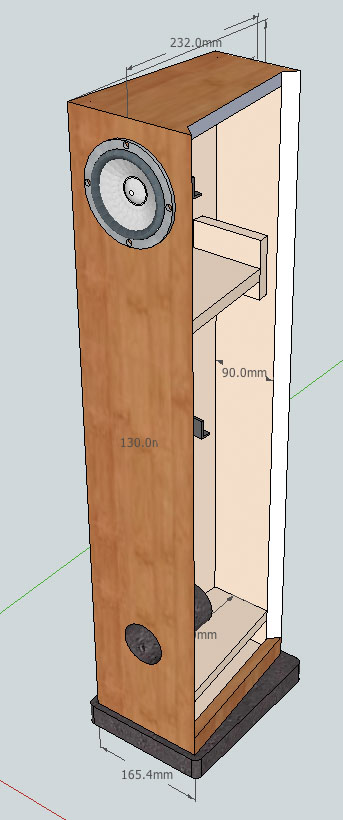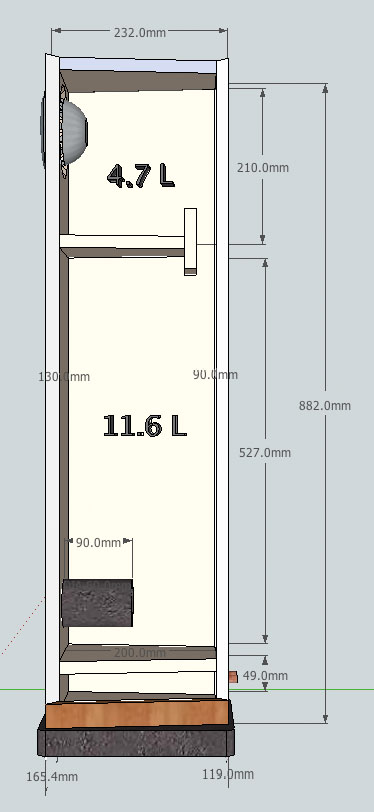hi cyburg/others 🙂
Long time ago I built the needles and have been listening to them for a while; the sound was marvelous. Since then I've upgraded to something else...
Now I'd like to build a pair of sticks, however I've never liked square boxes. Apart from sonic interference/standing waves, I just don't like the looks, too boxy.
If I read the drawings right, the insides are 14x14cm square, the top bass reflex (inside) is 24cm high. If I would like to build a slightly different box, say like the linn Ninka's with their beautiful slanted walls, what would I have to take into account to get the sound right?
For the inner volume of top and bottom reflex boxes (4,7 liters top) the calculations are easy, but I'm not so sure about the port length/diameter. What should I take into account for calculating the port size/length ?
top pic of ninka;s:
Long time ago I built the needles and have been listening to them for a while; the sound was marvelous. Since then I've upgraded to something else...
Now I'd like to build a pair of sticks, however I've never liked square boxes. Apart from sonic interference/standing waves, I just don't like the looks, too boxy.
If I read the drawings right, the insides are 14x14cm square, the top bass reflex (inside) is 24cm high. If I would like to build a slightly different box, say like the linn Ninka's with their beautiful slanted walls, what would I have to take into account to get the sound right?
For the inner volume of top and bottom reflex boxes (4,7 liters top) the calculations are easy, but I'm not so sure about the port length/diameter. What should I take into account for calculating the port size/length ?
top pic of ninka;s:
An externally hosted image should be here but it was not working when we last tested it.
where did the edit button go ?
Right, one small addition, the bottom port doesn;t matter, only the top (internal) port, i'll be using the normal port for the bottom.
Right, one small addition, the bottom port doesn;t matter, only the top (internal) port, i'll be using the normal port for the bottom.
It looks like the first port is 28cm2. Just keep the same area in your design. Let's say your cabinet is going to be only 10cm wide (internal) at the rear, so make the depth of the port 2.8cm. Or, there's nothing saying you couldn't put the port at the front of the cabinet and adjust the depth down. Also, there probably isn't a lot of sensitivety to where the whole length of the port resides. It could be contained entirely within the upper or lower chamber or anywhere in between, no just centered between the two. Lastly, a tube of 28cm2 by 8cm long could be substituted for even greater ease.
ok, thanks, i'll post some drawings & pics when building.
I even thought up a name: Stinka's Stick + Ninka
Stick + Ninka

I even thought up a name: Stinka's
 Stick + Ninka
Stick + Ninka
Sketchup!
OK, this is the general idea. I kept internal volumes identical to Cyburgs design (if my calculations are correct, that is🙂 ):




OK, this is the general idea. I kept internal volumes identical to Cyburgs design (if my calculations are correct, that is🙂 ):




tba 🙂
but i'm hesitating, just looked at a design based on a 135cm TL, supposedly sounds better than cyburgs double bass reflex... found one on a dutch diy board. he wasn't satisfied with bass behaviour and transplanted them into a TL. sooooo..... wait until i make up my mind 🙂
but i'm hesitating, just looked at a design based on a 135cm TL, supposedly sounds better than cyburgs double bass reflex... found one on a dutch diy board. he wasn't satisfied with bass behaviour and transplanted them into a TL. sooooo..... wait until i make up my mind 🙂
Last edited:
A TL is more flexible than this design. Easier to tune and modify, which is good when dealing with Tang Band drivers and their large deviations from published T/S specs.
I've done double bass reflexes and series double chambers and they are quite sensitive to small changes (minor mistakes in measurement or variations in driver characteristics). They frustrate me. TLs, on the other hand, do not frustrate me, and seem like they are more fun to play around with than a standard ported design. Is the one you're looking at a MLTL (mass loaded transmission line)? I've had good luck with MLTLs in particular, as they combine a port like found in a bass-reflex design and therefore add more tunability. Perhaps you could look into designing your own cabinatry by using Hornresp?
I've done double bass reflexes and series double chambers and they are quite sensitive to small changes (minor mistakes in measurement or variations in driver characteristics). They frustrate me. TLs, on the other hand, do not frustrate me, and seem like they are more fun to play around with than a standard ported design. Is the one you're looking at a MLTL (mass loaded transmission line)? I've had good luck with MLTLs in particular, as they combine a port like found in a bass-reflex design and therefore add more tunability. Perhaps you could look into designing your own cabinatry by using Hornresp?
if you don;t mind the googlized translation have a look at it here:
Google Bericht
and here
Google Bericht
Please note that the dutch generally *are* able to speak and write a language (called "Dutch") that actually makes sense. Most of the time, that is. 😉
Google Bericht
and here
Google Bericht
Please note that the dutch generally *are* able to speak and write a language (called "Dutch") that actually makes sense. Most of the time, that is. 😉
hi
I have question about notch filter.
I have purchased w4 655(don't know the letter) but I think it's diferent from w4 655SA. It has these specification:
Vas 5.09 Litr.
Qts 0.34
Qms 5,76
Qes 0.36
So, am I supposed to change the elements of the notch filter and how to do it?
I have question about notch filter.
I have purchased w4 655(don't know the letter) but I think it's diferent from w4 655SA. It has these specification:
Vas 5.09 Litr.
Qts 0.34
Qms 5,76
Qes 0.36
So, am I supposed to change the elements of the notch filter and how to do it?

I´m planning to build "sticks" or "needle". Which of them are the most allround?
What´s the advantage for the "sticks" and vice versa?
What´s the advantage for the "sticks" and vice versa?
The Sticks extend the low-end region tremendously due to the bass reflex design. The performance of this design depends heavily on speaker and listener alignment. Off-axis I find the performance actually unacceptably poor due to a thumpy and slow low-end response which suffers terribly from room modes (or the double BR, don't know really). I'm not quite sure if the BR design of the Sticks adds enough pro's to the con's.
On the other hand they do image really nice and are lovely to listen to on low volume. The imaging is also really, really (extremely?) beautiful on high volume in free field or in a well aligned and/or compensated room environment. Though I find them really, enormously picky in how they are positioned, driven and listened to. You are able to get excellent performance from them, but in a very tight, narrow and sensitive listening position. One seat, hold your head still, that is. 😉
I personally enjoy them very much on a (mostly) current-driven setup. This is the design which inspired me to continu with speaker design and acoustics fiddling. They are my example of how a listener could experience dynamically well defined and imaged music in contrast to the "compressed wall of sounds" which are sold commercially nowadays. They are cheap to build, though I would not invest more time or money than necessary.
I would not consider them allround by any amount. Not suitable for HT for example, you will get disappointed. But maybe that's to be expected with full-range. Above text is concluded with impressions rather than measurement. Also, I'm not a experienced speaker builder so I stand corrected to above and are open to tips or other information to improve performance further. 🙂
In conclusion:
Commercial 2-Way: Wham, bam in your face, these sound awesome! --> Get fed up and tired to listen to them in a short time.
Full-range: Hmm this is different, a bit empty and lifeless but (paradoxically) more engaging, they blend in the background -> Never get tired to listen to them.
On the other hand they do image really nice and are lovely to listen to on low volume. The imaging is also really, really (extremely?) beautiful on high volume in free field or in a well aligned and/or compensated room environment. Though I find them really, enormously picky in how they are positioned, driven and listened to. You are able to get excellent performance from them, but in a very tight, narrow and sensitive listening position. One seat, hold your head still, that is. 😉
I personally enjoy them very much on a (mostly) current-driven setup. This is the design which inspired me to continu with speaker design and acoustics fiddling. They are my example of how a listener could experience dynamically well defined and imaged music in contrast to the "compressed wall of sounds" which are sold commercially nowadays. They are cheap to build, though I would not invest more time or money than necessary.
I would not consider them allround by any amount. Not suitable for HT for example, you will get disappointed. But maybe that's to be expected with full-range. Above text is concluded with impressions rather than measurement. Also, I'm not a experienced speaker builder so I stand corrected to above and are open to tips or other information to improve performance further. 🙂
In conclusion:
Commercial 2-Way: Wham, bam in your face, these sound awesome! --> Get fed up and tired to listen to them in a short time.
Full-range: Hmm this is different, a bit empty and lifeless but (paradoxically) more engaging, they blend in the background -> Never get tired to listen to them.
Last edited:
will this work with markaudio chr 70.3 or shoud i stick(no pun intended) to building the pensils? TIA
A bit longer.
The Sticks are designed for the Tangband units and so is its filter. It will not work for the Markaudio drivers. The Pencils are a proven design.
Great drivers btw.
The Sticks are designed for the Tangband units and so is its filter. It will not work for the Markaudio drivers. The Pencils are a proven design.
Great drivers btw.
I´m planning to build "sticks" or "needle". Which of them are the most allround?
What´s the advantage for the "sticks" and vice versa?
The official Cyburg Needles are really a quite bad design. Voigt pipes have been shown to get great benefits from mass-loading. They also need to be specific to the driver used.
Can someone post a link to “Sticks”.
Perhaps the Woden Giraffe? It is outstanding, simplier (easier to build) with one of the very best small drivers you can buy today.
http://wodendesign.com/downloads/Giraffe-A52-MLTL-0v99-081015.pdf
It is sort of the Pensil for the A5.2/3 CHN-50.
I have a pair downstairs i can take a picture of it if you’d like to see.
There are more than a few tall slim ML-TLs for the CHR, do you have them already?
dave
Thanx. Scott has done a few double reflexes (which i have drawn). I personally am not convinced.
dave
dave
- Home
- Loudspeakers
- Full Range
- "Cyburgs-Stick" featuring W4-655SA